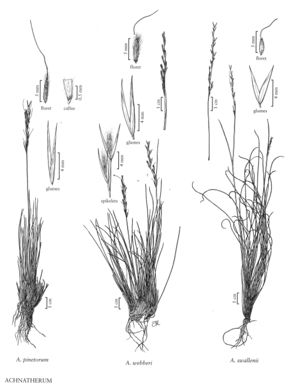Difference between revisions of "Achnatherum webberi"
FNA>Volume Importer |
FNA>Volume Importer |
||
| Line 23: | Line 23: | ||
-->{{Treatment/Body | -->{{Treatment/Body | ||
|distribution=Colo.;Utah;Calif.;Oreg.;Idaho;Nev.;S.Dak. | |distribution=Colo.;Utah;Calif.;Oreg.;Idaho;Nev.;S.Dak. | ||
| − | |discussion=<p | + | |discussion=<p>Achnatherum webberi grows in dry, open flats and on rocky slopes, often with sagebrush, at 1500-2500 m. It grows at scattered locations from Oregon and Idaho to California and Nevada. It differs from A. hymenoides in its cylindrical floret and non-saccate glumes, and from A. pinetorum and A. parishii subsp. parishii in its shorter, deciduous awns. It also has narrower blades than A. parishii subsp. depauperatum.</p> |
|tables= | |tables= | ||
|references= | |references= | ||
| Line 39: | Line 39: | ||
|basionyms= | |basionyms= | ||
|family=Poaceae | |family=Poaceae | ||
| + | |illustrator=Cindy Roché | ||
|distribution=Colo.;Utah;Calif.;Oreg.;Idaho;Nev.;S.Dak. | |distribution=Colo.;Utah;Calif.;Oreg.;Idaho;Nev.;S.Dak. | ||
|reference=None | |reference=None | ||
| Line 44: | Line 45: | ||
|publication year= | |publication year= | ||
|special status= | |special status= | ||
| − | |source xml=https:// | + | |source xml=https://bibilujan@bitbucket.org/aafc-mbb/fna-data-curation.git/src/314eb390f968962f596ae85f506b4b3db8683b1b/coarse_grained_fna_xml/V24/V24_183.xml |
|subfamily=Poaceae subfam. Pooideae | |subfamily=Poaceae subfam. Pooideae | ||
|tribe=Poaceae tribe Stipeae | |tribe=Poaceae tribe Stipeae | ||
Revision as of 17:06, 30 October 2019
Plants tightly cespitose, not rhizomatous. Culms 12-35 cm tall, 0.4-0.7 mm thick, smooth or antrorsely scabridulous; nodes 2-3. Basal sheaths glabrous, smooth or scabridulous; collars glabrous, without tufts ' of hair on the sides; basal ligules 0.1-1 mm, truncate to rounded; upper ligules 1-2 mm, acute; blades 0.5-1.5 mm wide when flat, usually folded to involute and about 0.5 mm in diameter, stiff, abaxial surfaces smooth or scabrous, adaxial surfaces scabrous. Panicles 2.5-7 cm long, 0.5-2 cm wide, contracted; branches appressed, longest branches 1-2 cm. Glumes subequal, 6-10 mm long, 0.6-0.9 mm wide, lanceolate, not saccate; florets 4.5-6 mm long, 0.7-1 mm thick, fusiform, terete; calluses 0.3-0.8 mm, blunt; lemmas evenly and densely pilose, hairs 2.5-3.5 mm, apical lobes 0.6-1.9 mm, membranous; awns 4-11 mm, readily deciduous, straight to once-geniculate, scabrous; paleas 4-5.6 mm, from as long as to slightly longer than the lemmas; anthers 1.6-2 mm, dehiscent, not penicillate. Caryopses 3.5-4.5 mm, fusiform. 2n = 32.
Distribution
Colo., Utah, Calif., Oreg., Idaho, Nev., S.Dak.
Discussion
Achnatherum webberi grows in dry, open flats and on rocky slopes, often with sagebrush, at 1500-2500 m. It grows at scattered locations from Oregon and Idaho to California and Nevada. It differs from A. hymenoides in its cylindrical floret and non-saccate glumes, and from A. pinetorum and A. parishii subsp. parishii in its shorter, deciduous awns. It also has narrower blades than A. parishii subsp. depauperatum.
Selected References
None.
